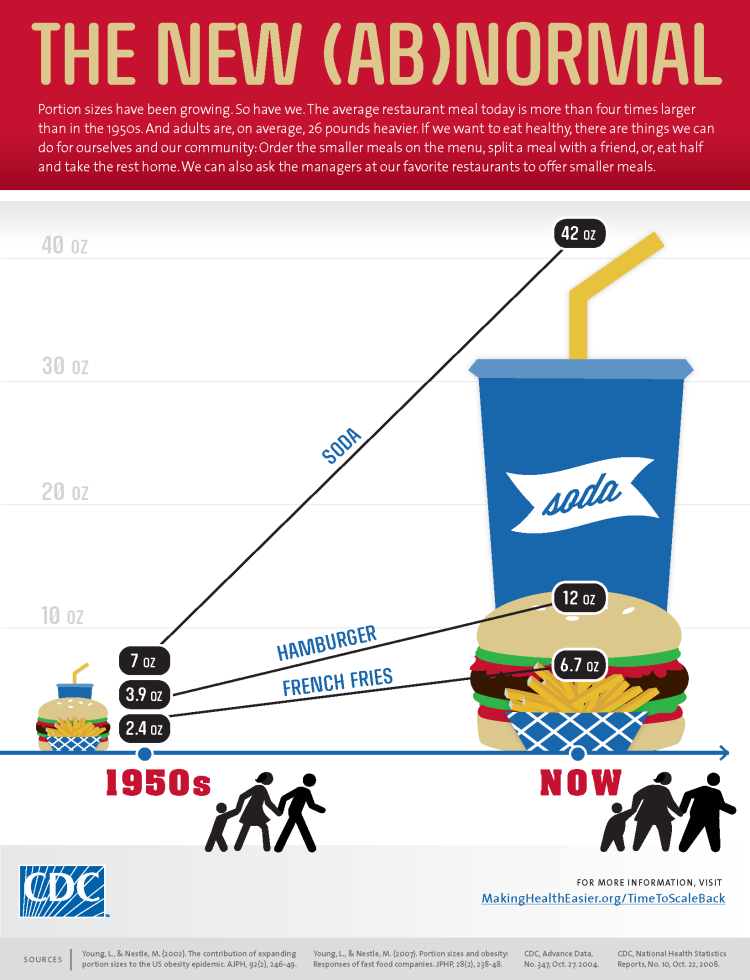2.7: Understanding Portion Sizes
- Page ID
- 20937
Learning Objective
- Judge food portion sizes for adequacy.
Estimating Portion Size
Have you ever heard the expression, “Your eyes were bigger than your stomach?” This means that you thought you wanted a lot more food than you could actually eat. Amounts of food can be deceiving to the eye, especially if you have nothing to compare them to. It is very easy to heap a pile of food on your plate, particularly if it is a big plate, and not realize that you have just helped yourself to three portions instead of one.
Part of healthful eating means choosing appropriate amounts of different foods, so knowing more about appropriate portion sizes can be useful. As seen in Figure \(\PageIndex{1}\), portion sizes at fast food restaurants have increased over the past several decades and consequently the typical meal contains more calories than it used to.

It's not just fast food portions that have increased...portion sizes of many foods have gotten larger. Understanding food portions and serving sizes can help as you build a healthy diet. Keep in mind that if you eat 2 servings of a food you need to double the calories and nutrients listed on the food label. Check out the video below to see if you know what 100 calories look like!
"Americans Guess What 100 Calories Looks Like" by BuzzFeedVideo
A sedentary lifestyle can make it difficult to expend enough calories during normal daily activities. Take the Portion Distortion Quiz at https://www.nhlbi.nih.gov/health/educational/wecan//downloads/portion-quiz.pdf to compare portions from the past to today's portions. The answers to the quiz include examples of the amount of physical activity required to burn off the extra calories provided by today's portions.
Dietitians have come up with some good hints to help people tell how large a portion of food they really have. Some suggest using common items such as a deck of cards while others advocate using your hand as a measuring rule. See Table \(\PageIndex{1}\) for some examples.1
| Amount | Object Comparison | Hand Comparison | Appropriate portion size for: |
|---|---|---|---|
| ½ cup | tennis ball | small handful | cooked pasta, cooked rice |
| 1 cup | baseball | average-sized fist | raw or cooked vegetables, whole fruits, beverages |
| 1 ounce | golf ball | nuts, cheese | |
| 3 ounces | deck of cards | average-sized palm of a hand | fish, chicken, beef, other meats |
| 1 Tablespoon | thumb | salad dressing, nut butters | |
| 1 teaspoon | postage stamp | thumb tip | oils, fats |
Managing portion sizes while eating away from home can be challenging. A restaurant meal can be equivalent to the recommended fat or calorie intake for an entire day! Suggestions on how to eat out in moderation include:
- Avoid breaded or fried foods
- Order salad with dressing on the side
- Ask for steamed vegetables
- Avoid cream sauces or cheese sauces
- Order small portions (such as appetizers)
- Split your entrée with a friend
- Eat ½ your entrée and take home the leftovers - you can ask the wait staff to put ½ your entree in a to-go box before you start eating
- Order broth-based soups instead of cream soups
- Order meat, fish, and poultry grilled or broiled
- Skip dessert or share with the table!
Key Takeaways
- Judging portion sizes can be done using your hand or household objects in comparison.
- Multiple strategies can be used to help manage portion sizes when eating away from home.
References
- Serving Size vs Portion Size: Is There a Difference? eatright.org. https://www.eatright.org/food/nutrition/nutrition-facts-and-food-labels/serving-size-vs-portion-size-is-there-a-difference. Accessed June 7, 2020.

